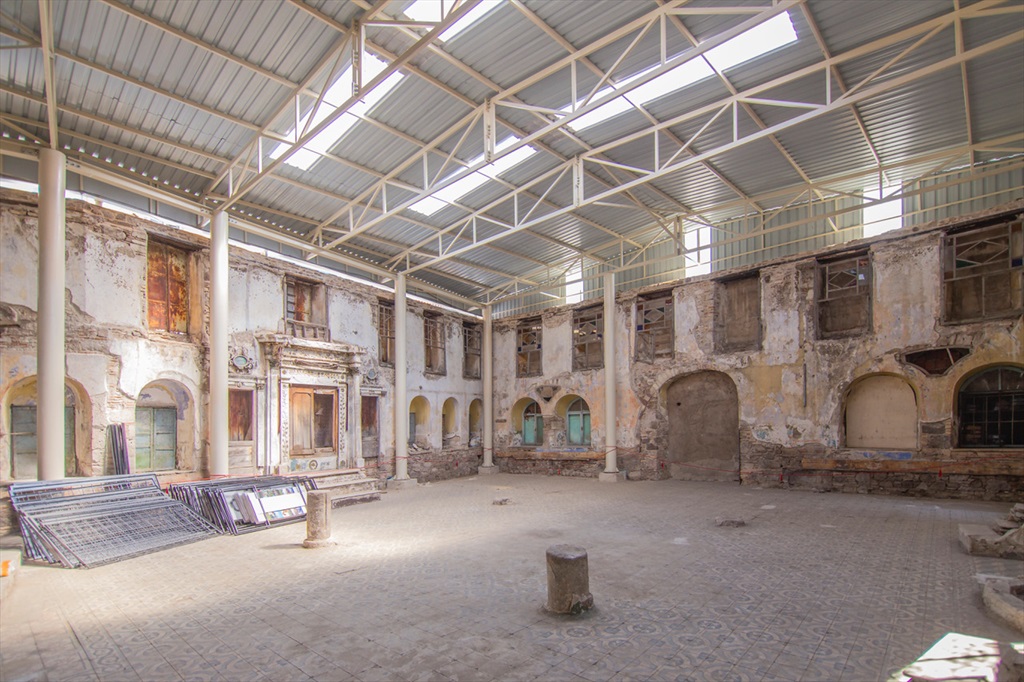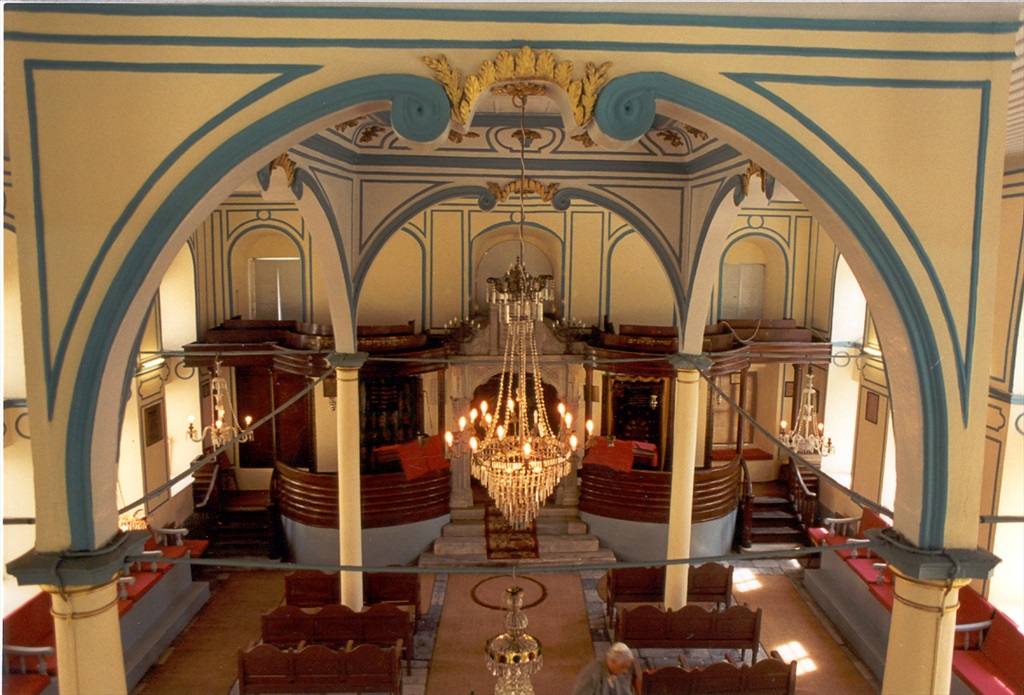When I was looking for a synagogue in Kemeraltı, I asked the merchants for directions.
-Here, here, here, everywhere synagogues. Which one are you looking for?
Indeed, there are many synagogues in the tiny area, back to back or right next to each other in Kemeraltı. It is exciting that such a small place holds such a great cultural treasure. Let's explore the Jewish Cultural Heritage of Kemeraltı together. It is estimated that the presence of the Jews, who were few in the city until the 16th century, around İzmir dates back to the Roman Period. The Jews who settled in and around Havra Street in Kemeraltı established Juderia, the Jewish quarter, and made it an important part of the city.
The nine synagogues and rabbinical buildings around the street, four of which were built adjacent to each other, constitute an architectural complex that is unique today.
The Jews, who left pieces of their own culture in the city for such a long period, became even more present with the arrival of Sephardic Jews who migrated to Tire and Manisa in 1492 and 1497, primarily from Spain and Portugal, to İzmir from the last quarter of the 16th century. Later, Palestinian Jews from Thessaloniki, İstanbul, Ankara, the Balkans, the Mediterranean islands, and an important group of Portuguese immigrants formed the Smyrna Jewish Community, and from the 19th century onwards, wealthy Italian Jews of Portuguese origin and poor Eastern European, especially Russian immigrants, also known as Ashkenazi, came to the city.
After all, as you can imagine, over the last four centuries, Jews have become an important part of İzmir. Today, this important cultural heritage can be found in a synagogue structure or a local flavor when you walk in the streets of Kemeraltı. In this article, we have prepared a very pleasant route for you to follow the traces left by the Jews to İzmir. During a day in the city, we will discover the region where they built their lives, namely the First Juderia; synagogues, the house of Hayim Palachi, one of the important Jewish rabbis, and the cortejos, which are the collection of houses where they live together, we will visit important points related to the heritage of the Jews of İzmir.
İzmir makes you feel that it is a city that embraces many cultures and still contains traces of these cultures today. The Bet Hillel Synagogue is one of these places. The Bet Hillel Synagogue, which was established as a religious academy in the Palachi family's home, reveals its fascinating past with its story. Rabbi Hayim Palaçi, whom Sultan Abdülmecit awarded as "the cleric responsible for justice," and his son Rabbi Avraham Palachi are important religious scholars of the Jewish Community of İzmir. Let's consider that the books written by Hayim Palachi continue to be taught as textbooks in religious schools in the world today. We can see once again how important the Bet Hillel Synagogue is. The Synagogue, Hayim Palachi's tomb in Gürçeşme Cemetery, and the purification pool (mikve) next to the tomb are called the Diamond Triangle. When the Bet Hillel Synagogue was destroyed during a fire in 2006, it was restored by the İzmir Metropolitan Municipality, then reopened its doors as the Rav Hayim Palachi Memorial House.
* Bet Hillel Synagogue can be visited on weekdays.

Our stop after the Bet Hillel Synagogue is the area where the old Rabbinical House building is located, which is located on the street that was once called the Chief Rabbi, where all the official affairs of the İzmir Jewish Community are done, where the central library of the community and the religious school is located. The congregation building was built in 1840 with the support of the Viennese Rothschild family and was completely vacated in 1997.
The founders of the Portuguese Synagogue, the only Synagogue whose name indicates where the immigrants were taken, are thought to have been Jews of Portuguese descent who emigrated from North Africa and Venice. The Portuguese Synagogue welcomes its visitors with its marble columned and pedimented entrance and is known to be the city's largest Synagogue in the 17th century. The Synagogue, which was destroyed several times as a result of earthquakes and fires, now serves as a Social and Cultural Activity Center after the restoration work initiated by EGİAD in 2017. In the area within the borders of the Agora of Smyrna, which is located directly opposite the Synagogue, there is the Agora Museum and Exhibition House.
.jpg)
Bikur Holim Synagogue, with its central Teva ceiling decorated with flower and fruit paintings, and plaster-embossed columns, offers a structure that will fascinate you within our route with being one of the most beautiful places of worship in İzmir. The building, which Salomon De Ciaves donated in 1724 to build a synagogue, was burned down in 1772. The Bikur Holim Synagogue was rebuilt by Manuel De Ciaves from the same family. The Synagogue, also known as the Çaves Havrası, took the name of "Bikur Holim," which means "patient visit," due to the use of the basement as a hospital in one of the most common epidemics in the city. It is estimated that the basement was also used as a Bet Din prison for a while. There is still worship in the Bikur Holim Synagogue, and you can visit this unique structure by appointment.
.jpg)
Havra Street, which took its name from the many synagogues in its immediate vicinity, was a lively shopping center where Kosher (Halal) food was produced and sold. According to their beliefs, the Jews of Izmir procured a significant part of their similar food needs, such as meat, fish, chicken, yogurt, cheese, and eggs from Havra Street. Like other foods, wine production was produced in and around this street in accordance with kosher rules.
When we examine the sources of the 19th century, we learn that there were Greek and Jewish wineries, a Turkish bath, and a Greek pharmacy on Havra Street. On the street, we understand from the motifs of grapes and vine leaves carved on the keystone at the arched entrance and the date 5660 (1900) written in the Hebrew calendar that this is a kosher winery.
Although a large part of the Jews of İzmir left the city when we came to today, the originality and commercial texture of the street will make your discovery much more valuable.
.jpg)
The Etz Hayim Synagogue, which means the tree of life, is estimated to be the city's first Synagogue and belongs to the Byzantine Period like other synagogues of the same name. In a document belonging to Salomon Ben Ezra, who died in 1688, it was mentioned that Muslim Turks prayed in the only Synagogue of İzmir. It is thought that the Period mentioned in this document coincided with the Period of the Turkish conquest of İzmir and that they prayed in this Synagogue because there was no mosque in the city.
The Etz Hayim Synagogue, which has had to be rebuilt many times due to fires, has been restored recently and opened its doors to visitors again with its admirable interior.

The Hevra Synagogue's name is "Talmud Torah" in ancient texts. In the 17th century, during the reign of Jozef Eskapa, this Synagogue, known to have existed, was exposed to fires and rebuilt many times. The building, which was rebuilt by Çelebi and Menahem Hacez brothers after the fire in 1838, remained in ruins for many years after being burned down again in the fire of 1841.
Hevra Synagogue, built in a central plan, is a typical İzmir synagogue with Teva (prayer reading chair), triple Ehal (cabinet where Torah rolls are stored) composition, and Midrash. Teva was inspired by Ottoman galleys that brought Jews from Spain, as in the Shalom Synagogue. Many Sefer Torahs (Torah scrolls) once found in the Hevra Synagogue gave it a prestigious status.
The roof of the Hevra Synagogue collapsed in 1999. Rescue work was completed in 2020, but the restoration of the Synagogue has not yet begun.

It is accepted that Isaac Algazi built it in 1724 because of the inscription at the entrance of the Algazi Synagogue. Another view claims that this Synagogue existed in the 17th century.
The basement was used both as a Midrash and where Asara Batlanim (a ten-year-old man) prayed all day long for the country's and its people's salvation. It was known as "El Kal de Abaşo" (Lower Synagogue).
Isaac Ben Salomon Algazi, another member of the Algazi family known to have trained prominent rabbis, is also a person associated with this Synagogue. Born in 1889, Isaac Algazi was educated at Hayim Palachi's Yeshiva Bet Hillel (religious school) and, like his ancestors, became Hazan at the Algazi Synagogue. Isaac Algazi was considered one of the most important religious, secular, and classical Turkish music composers.

The Siniora Synagogue is one of the areas rebuilt after the fire of 1841. The Synagogue, which is thought to have been built with the donations of Dona Gracia Nasi, the aunt of Yosef Nasi, who came to an important position in the Ottoman palace in the 17th century, famous by the nickname Giveret or La Siniora, is one of the most beautiful synagogues of the city with its interior decorations and a lush courtyard surrounded by high walls. The Siniora Synagogue also has a period when the fruits of the citrus tree in its courtyard gave hope to women who could not have children. For this reason, we can say that it is a very suitable area to take a closer look at miracles.

Now we turn our attention to the Shalom Synagogue, one of the most authentic İzmir synagogues, reminiscent of a typical Turkish house with its pencil-made ceiling, cedar, and floral pillows. The fire of 1841, which reduced the Jewish quarter to ashes, is said to have miraculously stopped in front of the Shalom Synagogue. You can read this story in the marble inscription at the entrance of the Synagogue. The building, also known as the Tulumbalı Synagogue, was also known as the Aydınlılar Havrası for a while when it was allocated to the Jews coming from Aydın in the 1930s. In addition, part of the Synagogue's garden was devoted to Ashkenazi Jews at the beginning of the 20th century.
.jpg)
Cortejos are structures that mean 'courtyard' in the Ladino language, where the understanding of life and architecture unique to Sephardic Jews is shaped. The cortejo, now known as 'Blue,' is one of the few cortejos known as the Jewish Houses that have survived to this day. Blue Cortejo, where a family lived in each of the rooms surrounding the courtyard with its tulumba courtyard, which has a common kitchen and toilet in traditional cortejo architecture, hosted those who migrated from Anatolia for many years after the community left here and began to be called "family home." Today, the historical cortejo operates as the service unit of İzmir Metropolitan Municipality.

Manisa Akhisar Hotel, an old cortejo, is one of the places to be seen as one of the rare buildings in the city that has preserved the cortejo architecture in its original form until today. In the jumpsuit in the middle of the courtyard, while the water needs of the cortejo, where a Jewish family stayed in each room for a while, the toilet and bathroom in the courtyard can be used today just as they were then.

Click here to see İzmir Jewish Heritage Route on the map!
.jpg)






Comments
No comment left, would you like to comment?